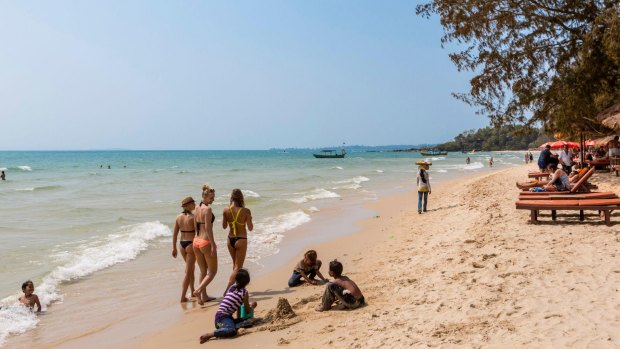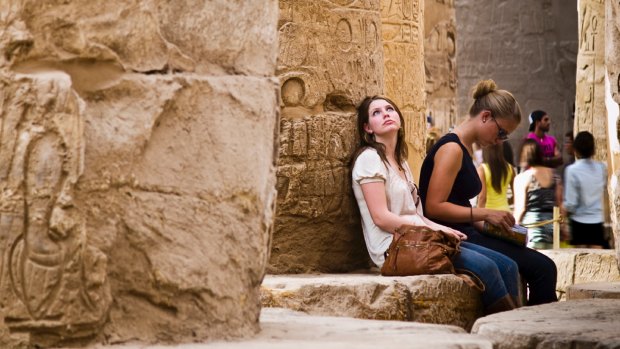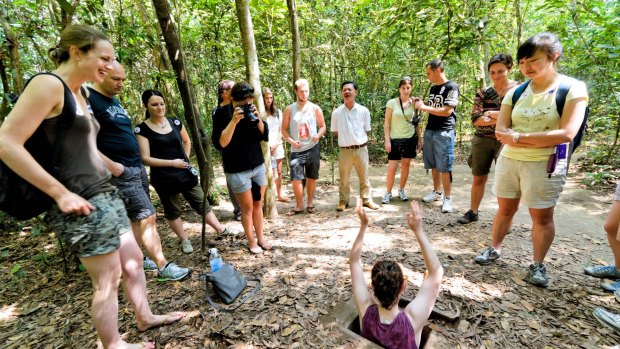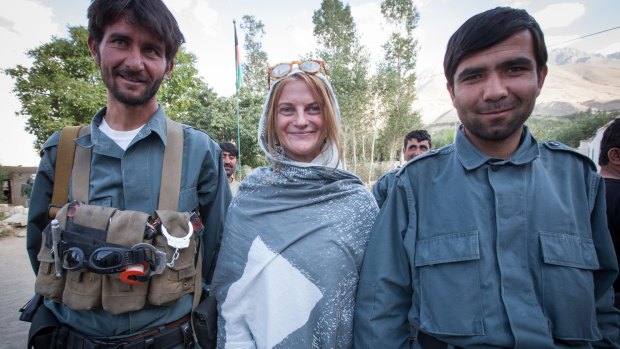This was published 7 years ago
Holidays in Cambodia, Iran, Peru and other former war zones: From no-go to tourist hotspot
By Ben Groundwater

A holiday in Cambodia? It's no joke these days.Credit: Alamy
Thirty years ago, everyone would have thought you were crazy. If you'd announced you were taking a holiday in Cambodia, as the Dead Kennedys sarcastically suggested, people would have checked you into a facility.
No one wanted to go to Cambodia back in the 80s, and even for a good part of the 90s. The country was in the very early stages of recovery from the Pol Pot regime, a totalitarian dictatorship responsible for the slaughter of about 25 per cent of Cambodia's entire population. Doesn't exactly sound like a relaxing holiday destination.
And yet today, Cambodia is a mainstream attraction. Your parents have not only stopped discouraging you from going there – they want to visit as well. Everyone wants to see the temples of Angkor around Siem Reap. They want to see the Killing Fields outside Phnom Penh. They want to hang out on the beach at Sihanoukville.

Egypt is sure to bounce back as a popular tourist destination.
It seemed unimaginable 30 years ago, but Cambodia is now a hugely popular tourism destination that relies on that industry to prop up its economy. You won't meet many backpackers who haven't been there.
This popularity is indicative of a fairly reliable phenomenon: today's warzone is tomorrow's tourist attraction. The places that seem like no-go zones today will eventually become the hot destinations of tomorrow.
The progress is easy to track. First the conflict ends, then the backpackers arrive, and then as word gets out and the infrastructure improves, so the mainstream tourists begin to trickle in. Pretty soon you have a hugely popular destination.

The Cu Chi tunnels, northwest of Ho Chi Minh City, were part of a much larger underground tunnel network used by the Viet Cong in the Vietnam War. Credit: Alamy
It happened to Cambodia, thanks to world-famous attractions like Angkor Wat, as well as the country's location, within striking distance of much of Asia and Australia, and its affordability.
It also happened to Peru, one-time home of the Shining Path militant group, a no-go zone for all but the most intrepid explorers, which now receives more than 4.5 million overseas visitors a year. It happened to Vietnam, and Myanmar, and Korea, and Cuba, and Germany, and many other countries besides.
What attracts tourists to these places? Is it the thrill of being able to visit a country that was once off limits? Is it the voyeurism of seeing a place you've only ever read about in the serious part of the newspaper? Is it the intrepid nature of being one of the first to arrive?

A tourist with Afghan army forces in Afghanistan.Credit: Alamy
It's probably all of those things for various people, but it could also be none of them. For many travellers the cessation of war is merely a chance to get in and explore a country they'd always wanted to see anyway. People would always want to see Machu Picchu, and Angkor Wat, and the temples of Bagan – the fact there used to be trouble around those sites is immaterial.
It does make you wonder, though, where the next hotspots will be. What are the current centres of conflict that we'll all be visiting in 20 or 30 years?
Iran is already on its way to becoming the next one. It will be a conventional destination before too long, provided the USA's sanctions don't change things too drastically. The local people there are too friendly, the historical and religious sites too amazing, for this place to stay off the mainstream radar for too much longer.
That's fairly predictable. Egypt, too, while going through a few issues at the moment, is sure to bounce back as a popular destination in the near future.
Of the others, I would sincerely hope that Pakistan can begin attracting tourists in the next few decades. Afghanistan, too, could one day be a hub for those chasing a more intrepid adventure. Maybe we'll all be talking about going there in 20 years time.
Yemen has some truly amazing attractions that people will eventually be able to go back there to see. Even Iraq, you'd hope, will one day see an influx of tourists keen to explore the historical sites that still stand there.
In fact of the current conflict zones, it's only really Syria and Somalia, sadly, that it seems difficult to imagine as tourist attractions of the near future.
In the case of the latter, I'm not sure what would draw people to visit Somalia, even without the conflict. For Syria, so much has been destroyed, and the road to recovery seems so long, that it would be bizarre to think of it as a genuine tourist destination in the coming decade. Syria needs plenty of support, but that's probably not going to come in the form of mainstream tourism for a long time yet.
Hopefully, however, one day the thought of a "holiday in Syria" will be the same as we now think of a holiday in Cambodia: a great idea. Until then, there's always Angkor Wat.
Which former warzones are now your favourite destinations? Which do you think will become popular in the next 10 to 20 years?
Email: b.groundwater@fairfaxmedia.com.au
Instagram: instagram.com/bengroundwater
Sign up for the Traveller Deals newsletter
Get exclusive travel deals delivered straight to your inbox. Sign up now.